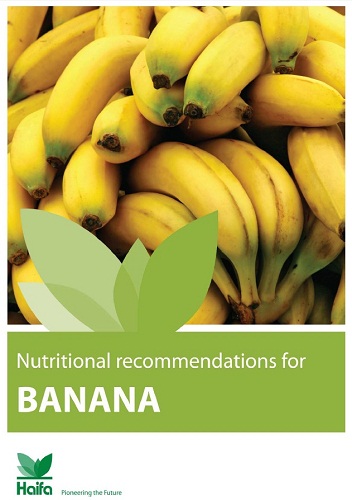How does soil fertility affect the banana plant? How can you identify nutrient deficiencies? What types of fertilizers give the best results? Our banana crop guide answers all these questions, and much more
Getting higher yield from your banana plants is not a matter of luck, but a result of knowledge and experience. Haifa, with its profound knowledge, gathered over decades, offers the banana grower this extensive and through crop guide.
The guide contains a comprehensive explanation of banana nutrition and detailed fertilization recommendations, alongside general information relevant for banana growing.
The banana crop guide can help you make the most out of your banana fertilizer, to provide higher yields and a better benefit/cost ratio.
Here is a small sample of some of the information to be found in this useful crop guide:
- Bananas grow well over a wide range of soils. The ideal soil should be well drained but have good water retention capacity. Soil pH should be between 5.5 and 6.5. Soil must not be compact.
- Bananas grow best in areas with 2,500 mm or more of well-distributed rainfall per year. Irrigation is needed if rainfall is inadequate or irregular. Banana plants do best in protected areas, because they are susceptible to wind damage. Average temperature of 27oC (81oF) and full sun are also beneficial for optimum plant development and yields.
- Banana is a plant with a rapid growth rate, high water consumption, shallow and spreading roots distribution, roots with weak penetration strength into the soil, poor ability to draw water from drying soil, low resistance to drought, and rapid physiological response to soil water deficit.
- Nitrogen is the chief promoter of growth. It induces the vegetative growth of the pseudostem and leaves providing them the desired healthy green color.
- The greater the number of large, healthy leaves, produced during the first 4-6 months, the larger will be the size of the fruit bunch.
- Due to the very high K contents in the banana fruit and leaves, K is considered the most important plant nutrient in banana production. The amount of K taken up from the soil and removed from the field in harvested bunches is very high. Estimated annual soil losses through fruit removal alone can be 400 kg of elemental K (equivalent to 480 kg of K2O) per ha with a production of 70 tons of fruit.
Contents:
- Growing bananas
- Plant nutrition
- Haifa's products performances
- Fertilization recommendations
- Haifa specialty fertilizers
- Conversion tables
Want to learn more about growing bananas and obtaining high yield? Download the complete banana crop guide
This guide joins our line of specific crop guides: Pepper, Tomato, Cucumber, Potato, Citrus, Rice, Olive and Strawberry.




